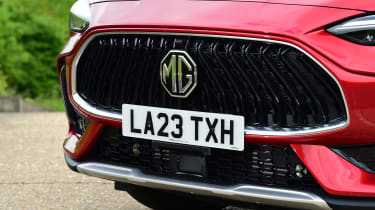MG HS (2018-2024) - MPG, CO2 and running costs
The MG HS has low fuel economy along with high tax and insurance costs, making it pricey to run

Just so you know, this is an older review of the 2018-2024 MG HS. If you are interested in information about the running costs of the latest MG HS, or news of upcoming MG models, please follow the links provided.
The most important priority for family motoring is keeping an eye firmly on running costs. Despite the car being a fairly big SUV, MG has wisely chosen to steer away from offering the HS with all-wheel drive or adding huge alloy wheels – both of which adversely affect fuel consumption and increase CO2 emissions.
However, the simple fact is the basic turbocharged petrol engine powering this 1.5-tonne SUV is not going to return the best economy figures, especially compared to rivals that are equipped as standard with hybrid powertrains or fuel-saving cylinder-deactivation tech.
The HS petrol delivers 37.9mpg at best when paired with the six-speed manual gearbox, while the seven-speed auto manages only 36.6mpg on the WLTP combined cycle. Poor fuel economy means high CO2 emissions, which start from 168g/km for the manual and go up to 174g/km for the automatic. Neither version will appeal to company car drivers, because all versions of petrol HS is in the top 37 per cent Benefit-in-Kind (BiK) rate.
Used - available now

2022 Kia
Sorento
37,674 milesAutomaticPetrol1.6L
Cash £26,700
2022 Toyota
Corolla
23,108 milesAutomaticPetrol1.8L
Cash £16,500
2022 Mercedes
CLA
73,131 milesAutomaticPetrol1.3L
Cash £20,100
2020 Hyundai
Kona Electric
41,990 milesAutomaticElectric
Cash £12,200The plug-in hybrid HS, starting at a smidge over £31,000, sacrifices the standard model’s attractively low starting price point, but offers much lower emissions and will be the one to go for if you’re looking to run a HS as a company car. As well as a 32-mile electric driving range, MG claims the HS PHEV model can return up to 155.8mpg. A CO2 figure of 43g/km puts the plug-in HS in the 12 per cent BiK tax bracket for company car drivers.
Electric range, battery and charging
The MG HS Plug-in Hybrid uses a single electric motor that draws power from a 16.6kWh battery (14.9kWh useable). MG claims the set-up allows up to 32 miles of pure-electric driving, or 44 miles if you’re just driving in town. Like most plug-in hybrids, the plug-in MG HS doesn’t have any rapid-charging capabilities, so fully recharging the battery will take around three hours using a 7kW home wallbox.
Insurance
Insurance premiums for the MG HS will be much higher than they were just a few years ago. The petrol model previously sat in insurance groups 16-18, but the updated versions now land in groups 21-22, which is higher than more expensive rivals such as the Hyundai Tucson and Kia Sportage.
Meanwhile, the plug-in hybrid HS sits in groups 31-33, depending on specification. Again, this is higher than many of its rivals, like the Ford Kuga.
Our Car Tax Checker tool lets you check your tax status and renewal date in seconds. Check your VED car tax now...
Depreciation
Our latest industry data suggests that after three years and 36,000 miles of ownership, the HS range should retain between 44 and 48 per cent of its original list price, with the worst being the plug-in hybrid in SE trim, with the best performing being the entry-level 1.5 SE manual.
To get an accurate valuation on a specific model check out our valuation tool...










